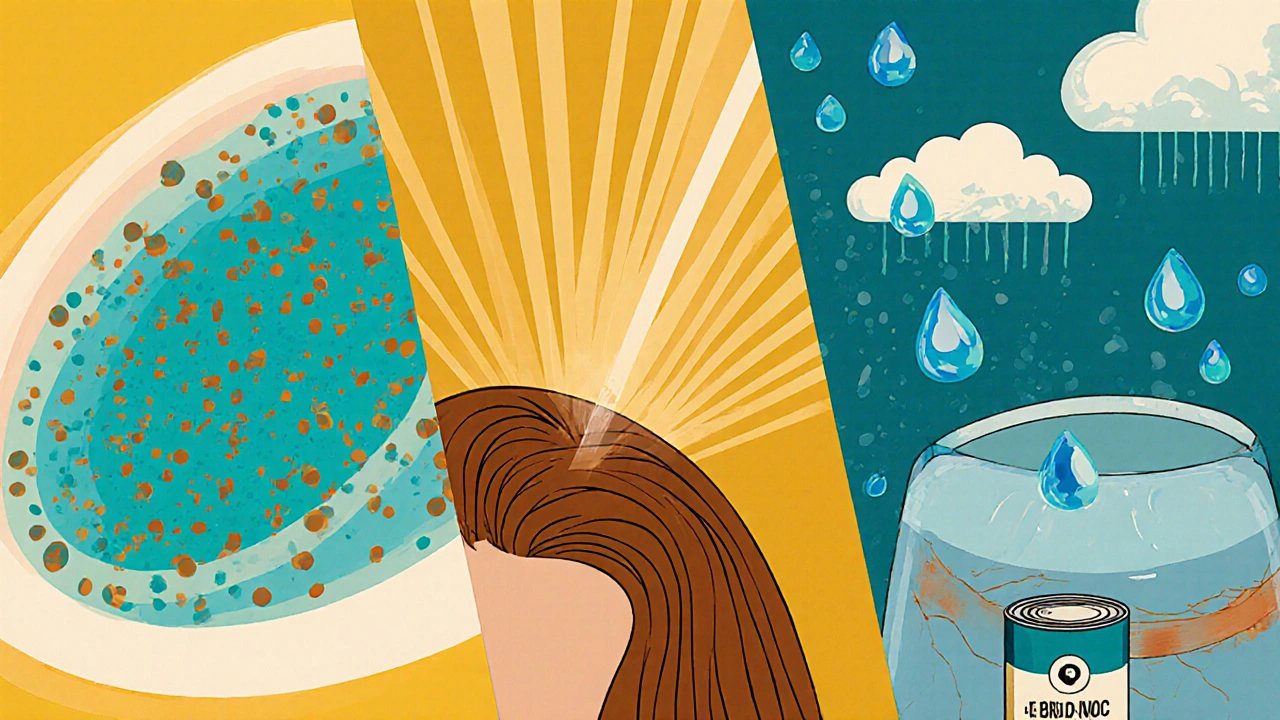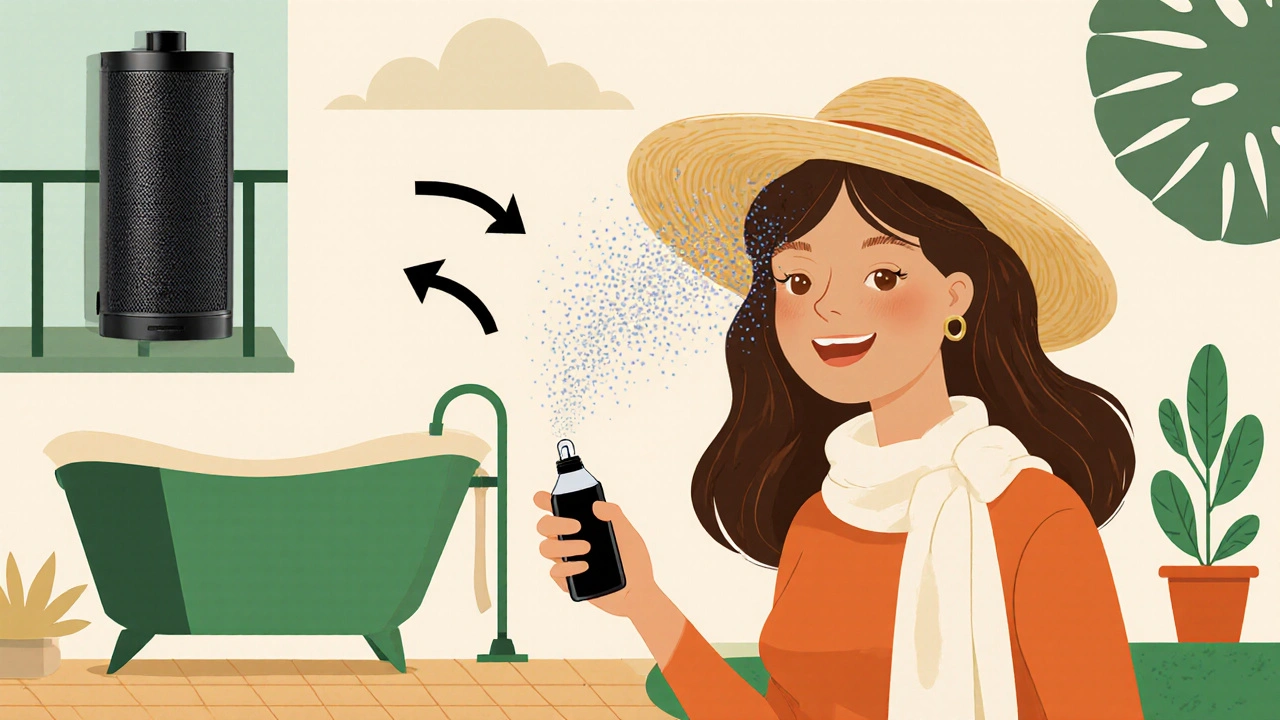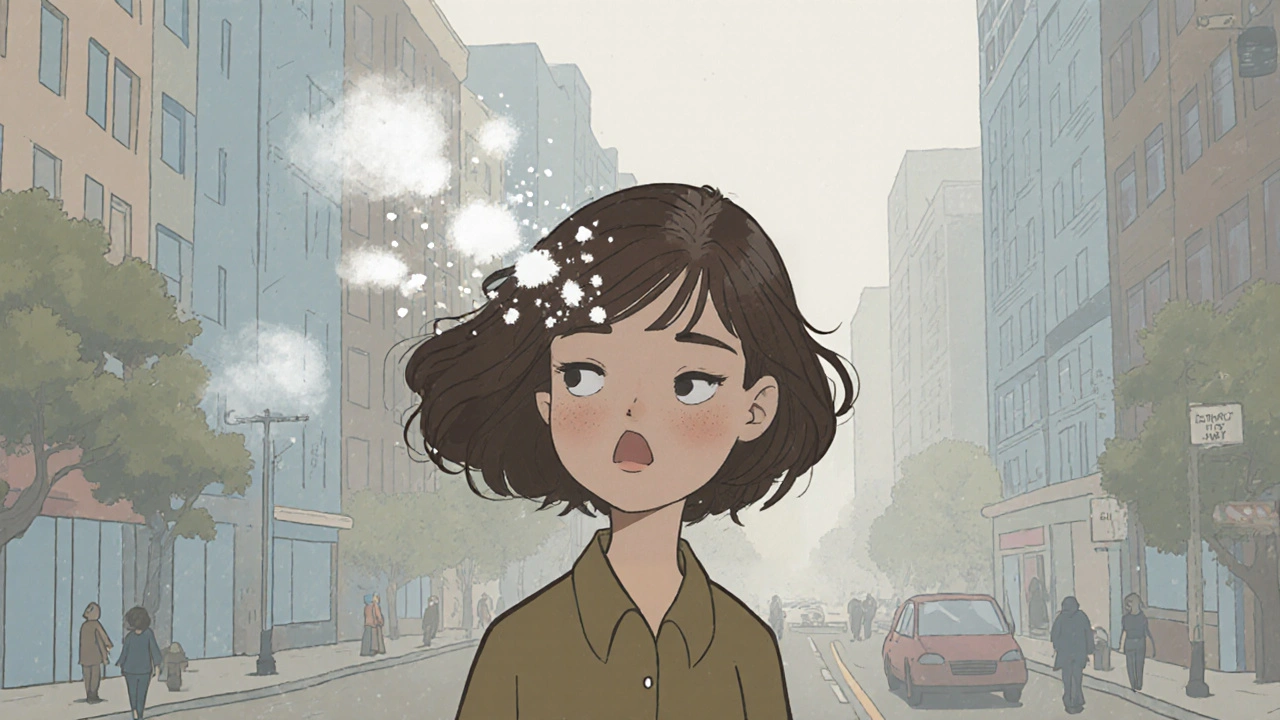Hair Health Pollution Impact Calculator
Pollution Impact Assessment
Enter your local air quality data to estimate potential hair health impact. Based on research showing a 6% increase in hair thinning for every 10 µg/m³ rise in PM2.5.
Estimated Impact
Recommended Actions
Enter your air quality data to see personalized recommendations.
Ever notice your hair looking duller after a smoggy day or feeling more brittle during a scorching summer? Hair loss is a condition where hair strands fall out faster than they grow, leading to thinning or bald patches. While genetics and hormones take most of the spotlight, the environment you breathe, sit in, and bathe under plays a bigger role than you might think. This guide breaks down how air pollution, climate shifts, and everyday chemicals mess with your scalp, and gives you practical steps to keep your locks healthy.
Air Pollution: The Invisible Hair‑Killer
Air pollution is the presence of harmful particles and gases in the atmosphere that degrade air quality. It isn’t just a lung issue; pollutants settle on your scalp, clog hair follicles, and trigger oxidative stress.
- Particulate Matter (PM2.5): These tiny particles can penetrate the skin barrier, reaching the follicle’s stem cells. A 2023 study of 2,800 urban dwellers found that a 10 µg/m³ rise in PM2.5 correlated with a 6 % increase in self‑reported hair thinning.
- Ozone (O₃): Reactive gas that damages the lipid layer of hair cuticles, leaving strands brittle and prone to breakage.
- Nitrogen Dioxide (NO₂): Increases scalp inflammation, which can accelerate the transition of hair from the growth phase (anagen) to the resting phase (telogen).
When pollutants settle, they also feed scalp‑resident bacteria and fungi, upsetting the scalp microbiome the community of microorganisms that keep the scalp balanced. An overgrowth of Malassezia yeast, for example, leads to dandruff‑type irritation that further weakens hair roots.
Climate Change and UV Radiation: Sun‑Burned Strands
Climate change is the long‑term shift in temperature and weather patterns caused by human activities, and its side‑effects hit your hair in three ways.
- Increased UV Exposure: Higher ozone depletion means more ultraviolet‑A (UVA) and ultraviolet‑B (UVB) rays reach the surface. UV photons break down the protein keratin, the building block of hair, causing loss of elasticity and color fading.
- Extreme Heat Waves: Elevated scalp temperature speeds up sebum oxidation, making the scalp oily and clogging follicles.
- Changing Humidity: Erratic humidity swings cause hair shafts to swell and contract, leading to micro‑fractures that eventually snap off.
One longitudinal study in Shanghai linked a 5 °C rise in average summer temperature to a 12 % uptick in androgenic alopecia diagnoses over a decade.
Heavy Metals in Water: Silent Saboteurs
Metals like lead, cadmium, and nickel can leach into tap water from aging pipes or industrial runoff. When you rinse your hair, these metals coat the shaft and enter the follicle.
- Lead disrupts the normal cycling of hair follicles by interfering with calcium signaling.
- Cadmium generates free radicals that damage DNA in hair‑matrix cells.
- Nickel can trigger allergic contact dermatitis on the scalp, a known trigger for telogen effluvium.
A 2022 water‑quality survey of 15 UK cities found that 18 % of households had detectable lead levels above the WHO safe limit, correlating with higher reports of hair brittleness.
Temperature Extremes and Humidity: The Daily Grind
Even without climate‑change headlines, everyday weather swings matter.
- Cold, dry air reduces scalp moisture, leading to flaky scalp that irritates follicles.
- Hot, humid environments cause sweat to mix with sebum, creating a fertile ground for bacterial overgrowth.
- Sudden temperature changes-like stepping from an air‑conditioned office into a cold street-can cause the cuticle to contract rapidly, creating split ends and breakage.
By tracking your local humidity and adjusting your hair‑care routine accordingly, you can offset many of these stressors.

Indoor Air Quality: The Home Isn’t Safe Either
Many assume indoor air is cleaner, but household chemicals can be just as harmful.
- Volatile Organic Compounds (VOCs) from paints, cleaning agents, and synthetic fragrances settle on hair, weakening the cuticle.
- Dust mites and pet dander trigger scalp inflammation in sensitive individuals.
- Smoking-whether you’re the one lighting up or just exposed to second‑hand smoke-introduces nicotine and tar that constrict blood vessels, reducing nutrient flow to hair follicles.
Improving ventilation and using low‑VOC products can dramatically reduce your scalp’s toxic load.
How Environmental Stress Interacts with Hormones and Genetics
It’s not a simple cause‑and‑effect. Pollution and climate stress can amplify existing hormonal imbalances disruptions in hormones like DHT, estrogen, and cortisol that regulate hair growth. Oxidative stress from pollutants increases the activity of 5‑α‑reductase, the enzyme that converts testosterone to DHT, the primary culprit in male‑pattern baldness.
Meanwhile, genetic predisposition determines how resilient your follicles are to these external attacks. People with the AR gene variant may see faster progression when exposed to high‑pollution environments.
Practical Steps to Shield Your Hair from Environmental Damage
- Cleanse wisely: Use a gentle, sulfate‑free shampoo that contains antioxidants (green tea, vitamin E) to neutralize free radicals.
- Condition the scalp: Apply a lightweight, non‑comedogenic scalp serum with niacinamide to improve barrier function and blood flow.
- Protect from UV: Wear a hat or spray a UV‑protectant mist (SPF 15+ for hair) on sunny days.
- Filter water: Install a carbon‑based shower filter to trap heavy metals and chlorine.
- Air purify indoor spaces: Use HEPA filters and choose low‑VOC cleaning products.
- Stay hydrated and balanced: Adequate water intake supports scalp moisture; a diet rich in zinc, biotin, and omega‑3 fatty acids supplies building blocks for keratin.
- Limit heat styling: Hot tools exacerbate cuticle damage caused by UV and pollutants.
- Regular scalp massage: Increases circulation, helping deliver nutrients that counteract pollutant‑induced vascular constriction.
Following this checklist can shave years off the timeline of environmentally induced hair loss.

When to Seek Professional Help
If you notice sudden shedding (>100 hairs/day), persistent scalp itching, or uneven bald patches, it’s time to consult a dermatologist or trichologist. Professionals can run a trichogram, blood tests for hormonal panels, and scalp‑culture analysis to pinpoint whether pollutants are the driving factor.
Early intervention-often with topical minoxidil, low‑level laser therapy, or anti‑inflammatory shampoos-offers the best chance to reverse or stall the process.
Quick Reference Checklist
- Check local air‑quality index (AQI) daily; if PM2.5 > 35 µg/m³, wear a breathable scarf.
- Use a UV‑protectant spray in summer months.
- Install a shower filter if your water test shows heavy‑metal levels above 10 ppb.
- Swap household cleaners for vinegar‑based or enzyme‑based alternatives.
- Schedule a scalp health check if shedding exceeds normal ranges.
| Pollutant | Primary Effect on Hair | Typical Sources |
|---|---|---|
| PM2.5 | Oxidative stress, follicle blockage | Vehicle exhaust, industrial fumes |
| Ozone (O₃) | Cuticle degradation, brittleness | Urban smog, photochemical reactions |
| Heavy metals (lead, cadmium) | DNA damage, allergic dermatitis | Old plumbing, mining runoff |
| UV radiation | Keratin breakdown, color fading | Sunlight, tanning beds |
| VOCs | Cuticle weakening, scalp irritation | Paints, cleaning agents |
Frequently Asked Questions
Can wearing a hat really protect my hair from pollution?
A hat acts as a physical barrier, catching particulate matter before it settles on the scalp. Choose breathable fabrics like cotton or bamboo to avoid trapping heat and moisture, which could create a different set of problems.
Is there a link between climate‑induced stress and androgenic alopecia?
Yes. Heat and UV exposure increase the activity of 5‑α‑reductase, the enzyme that converts testosterone into dihydrotestosterone (DHT). Higher DHT levels accelerate the miniaturization of hair follicles in genetically susceptible individuals.
Do water‑softening filters help with hair loss?
Softening filters primarily remove calcium and magnesium, but they don’t target heavy metals. For hair‑related concerns, a carbon‑based shower filter that captures lead, chlorine, and VOCs is more effective.
How often should I wash my hair if I live in a polluted city?
Aim for every 1‑2 days with a gentle, antioxidant‑rich shampoo. Over‑washing strips natural oils, while under‑washing lets pollutants accumulate. Adjust based on scalp oiliness and activity level.
Can diet offset environmental damage to hair?
A nutrient‑dense diet supplies the building blocks for keratin and antioxidants that neutralize free radicals caused by pollution. Foods rich in zinc, selenium, omega‑3s, and vitamins A, C, and E are especially protective.


Sebastian Green
October 21, 2025 AT 00:40I've definitely felt my hair get dull after a day stuck in traffic smog, especially when the humidity spikes and the scalp feels itchy. It helps me keep a simple routine: rinse with cool water and use a gentle antioxidant shampoo. Staying hydrated and eating leafy greens seems to give my follicles a little extra resilience.
Wesley Humble
October 24, 2025 AT 12:00From a mechanistic standpoint, the particulate matter (PM2.5) penetrates the stratum corneum, inducing oxidative stress pathways that up‑regulate matrix metalloproteinases, thereby compromising follicular integrity. Empirical data from the 2023 urban cohort indicate a statistically significant 6 % increase in reported hair thinning per 10 µg/m³ rise in PM2.5 (p < 0.01). Moreover, ozone (O₃) catalyzes lipid peroxidation within the cuticle, leading to brittleness and breakage. The correlation between nitrogen dioxide exposure and accelerated entry of follicles into telogen phase has been corroborated by dermatological histology studies. Consequently, mitigation strategies such as HEPA filtration and topical antioxidant serums are not merely cosmetic but evidence‑based interventions. 😊📊
Rajesh Myadam
October 27, 2025 AT 22:20Living in a city with fluctuating AQI, I've started checking the daily forecast and adjusting my hair care accordingly-using a lightweight, sulfate‑free shampoo on high‑pollution days and adding a UV‑protectant mist before heading out. The scalp feels less irritated when I keep the environment in mind, and I've noticed fewer split ends during the summer heat. It's a small habit, but the difference adds up over months.
Israel Emory
October 31, 2025 AT 09:40Indeed, the correlation you mentioned is not merely anecdotal; however, it is critical to acknowledge that over‑reliance on a single metric-such as AQI-may obscure other contributory variables, including indoor VOC concentrations, personal humidity exposure, and even dietary antioxidant intake; therefore, a multifactorial approach, integrating regular scalp exfoliation, consistent hydration, and strategic use of mineral‑based shampoos, yields a more robust defense against environmental insult.
barnabas jacob
November 3, 2025 AT 21:00Yo, those heavy metals in tap water totally mess up your keratin synthesis, bro.
jessie cole
November 7, 2025 AT 08:20While I appreciate the statistical rigor, let us not forget the human element: a calm mindset and consistent scalp massage can dramatically improve blood flow, delivering nutrients that counteract the oxidative onslaught described earlier. In my practice, clients who incorporate a five‑minute nightly massage report noticeably thicker strands within weeks. Hence, merging data‑driven tactics with simple, nurturing habits creates a truly holistic regimen.
Ron Lanham
November 10, 2025 AT 19:40It is absolutely essential to recognize that environmental stressors do not act in isolation but rather synergistically amplify the underlying hormonal pathways that govern hair cycle dynamics. For instance, chronic exposure to elevated ultraviolet radiation not only degrades keratin but also stimulates the activity of 5‑α‑reductase, thereby increasing dihydrotestosterone levels which accelerate follicular miniaturization in susceptible individuals. Simultaneously, particulate matter infiltrates the scalp's microbiome, fostering dysbiosis that precipitates inflammatory cascades and compromises barrier function. This inflammatory milieu, when combined with heat‑induced sebum oxidation, creates a perfect storm for telogen effluvium to emerge. Moreover, heavy metals such as lead and cadmium generate reactive oxygen species that directly damage DNA within hair matrix cells, further impairing regenerative capacity. The cumulative effect of these insults is akin to wearing a weight vest while trying to run a marathon; the follicle's resilience is steadily eroded. Evidence from longitudinal studies in Shanghai demonstrates a 12 % rise in androgenic alopecia prevalence correlating with a mere five‑degree Celsius increase in average summer temperature, underscoring the climate‑hair link. In addition, indoor pollutants like VOCs settle on the hair shaft, weakening the cuticle and facilitating breakage, which, while not true alopecia, contributes to the perception of thinning. Dietary deficiencies, particularly in zinc and omega‑3 fatty acids, exacerbate these vulnerabilities by limiting the availability of essential cofactors for antioxidant enzymes. Therefore, a comprehensive management plan must address not only external exposures but also internal nutritional status. Practical steps include installing carbon‑based shower filters to remove heavy metals, using antioxidant‑rich shampoos containing green tea extract, and applying scalp serums with niacinamide to reinforce barrier integrity. Regular scalp massage can also stimulate microcirculation, delivering oxygen and nutrients more efficiently to compromised follicles. Finally, seeking professional evaluation when shedding surpasses normal thresholds ensures timely intervention with modalities such as minoxidil or low‑level laser therapy. By integrating these strategies, individuals can substantially mitigate the accelerated hair loss trajectory imposed by our increasingly polluted environment. Consistent application of these measures not only preserves existing density but also fosters an environment conducive to regrowth.
Kate McKay
November 14, 2025 AT 07:00That's a solid roadmap; I especially love the reminder about omega‑3s-adding a handful of walnuts or a fish oil supplement has made my hair feel noticeably stronger during the summer heat.
Demetri Huyler
November 17, 2025 AT 18:20Frankly, the endless focus on pollutants distracts from the real issue: our nation's failure to uphold industrial standards that protect both citizens and their hair. While foreign researchers trumpet their studies, they ignore the fact that American ingenuity can develop advanced filtration technologies without bowing to global regulatory fatigue. It's high time we prioritize domestic innovation over imported alarmism.
Matthew Hall
November 21, 2025 AT 05:40Look, the whole "innovation" narrative is a smokescreen; the real agenda is to keep us buying expensive gadgets so the elite can keep control over the market while they flood the air with undisclosed chemicals that they claim are "harmless."
Kirsten Youtsey
November 24, 2025 AT 17:00While one might be tempted to ascribe nefarious intent to every industrial advancement, such conjecture often overlooks peer‑reviewed epidemiological data that substantiate the causal link between atmospheric particulates and follicular degeneration, thereby rendering simplistic conspiratorial narratives both unproductive and intellectually lazy.